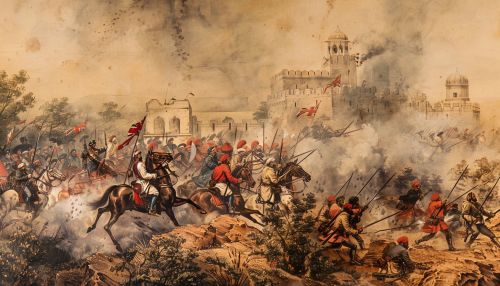Second Anglo-Sikh War
Background
The Second Anglo-Sikh War was a conflict between the Sikh Empire and the British East India Company that took place between 1848 and 1849. This war resulted in the annexation of the Sikh Empire into the British Raj. The conflict followed the First Anglo-Sikh War (1845-1846), which had significantly weakened the Sikh Empire and led to British interference in its internal affairs.
Causes of the War
The primary causes of the Second Anglo-Sikh War can be traced to the political instability within the Sikh Empire following the death of Maharaja Ranjit Singh in 1839. The power vacuum led to a series of weak rulers and internal strife. The British East India Company, having already established a foothold in the region after the First Anglo-Sikh War, sought to exploit this instability to expand its influence.
The immediate cause of the war was the rebellion of Dewan Mulraj, the governor of Multan, against the British-appointed Sikh regent, Maharaja Dalip Singh. Mulraj's refusal to pay taxes and his subsequent siege of Multan in April 1848 triggered the conflict.
Course of the War
Siege of Multan
The war began with the Siege of Multan, where Dewan Mulraj held out against British forces. The siege lasted from April 1848 to January 1849. Despite initial resistance, the British, under the command of General Whish, eventually captured Multan after heavy bombardment and fierce fighting.


Battle of Ramnagar
The Battle of Ramnagar took place on November 22, 1848. The Sikh forces, led by Sher Singh Attariwalla, initially managed to hold their ground against the British cavalry. However, the British, under the command of General Sir Hugh Gough, regrouped and forced the Sikhs to retreat across the Chenab River.
Battle of Chillianwala
One of the most significant and bloodiest battles of the war was the Battle of Chillianwala, fought on January 13, 1849. The British forces, again under General Gough, faced a well-entrenched Sikh army. The battle was fiercely contested, with heavy casualties on both sides. Although the British claimed a tactical victory, the high number of casualties and the inability to decisively defeat the Sikhs led to criticism of Gough's leadership.
Battle of Gujrat
The decisive Battle of Gujrat took place on February 21, 1849. The British forces, now reinforced and better prepared, launched a coordinated assault on the Sikh positions. The Sikh army, commanded by Sher Singh Attariwalla, was overwhelmed by the superior firepower and tactics of the British. The defeat at Gujrat effectively ended the Sikh resistance.
Aftermath
Following the defeat at the Battle of Gujrat, the Sikh leaders surrendered to the British. The Treaty of Lahore was signed on March 29, 1849, officially marking the end of the Sikh Empire. The annexation of Punjab into the British Raj was formalized, and Maharaja Dalip Singh was exiled to Britain.
The Second Anglo-Sikh War had significant implications for the region. The British consolidated their control over Punjab, which became a crucial part of their Indian empire. The annexation also marked the end of the independent Sikh state, which had been a major power in northern India.
Legacy
The Second Anglo-Sikh War left a lasting impact on the history of India and the Sikh community. The war demonstrated the military prowess of the Sikh soldiers, who fought bravely despite being outnumbered and outgunned. The annexation of Punjab also led to significant social and economic changes in the region, as the British implemented their administrative and legal systems.
The war is remembered for its intense battles and the valor displayed by both sides. It also marked the beginning of a new era in Punjab's history, as the region became an integral part of the British colonial empire.
